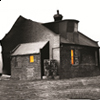Editors’ Choice: reviews of Christobel Kent, The Crooked House; D.D. Johnston, The Secret Baby Room; Paula Hawkins, The Girl on the Train; and Liane Moriarty, The Last Anniversary
 A mark of good crime fiction is that readers can intensely experience the spaces through which the characters move or in which they are trapped. Whether they are in urban mean streets or small towns, buildings are more than background or setting. They can generate the fears and desires that drive characters to commit crimes; they conceal secrets and retain the impress of crimes committed; protagonists may dread to enter them or feel a false sense of security when they lock the doors. Three excellent recent crime novels construct gripping narratives that centre on the manifold ways in which buildings are perceived, experienced and remembered. In Christobel Kent’s atmospheric novel, The Crooked House, the house of the title is a gothic embodiment of past terrors, containing the lost narrative of a murdered family; in D. D. Johnston’s forthcoming The Secret Baby Room, an almost equally gothic building, a derelict tower block, summons up the protagonist’s worst fears; and in Paula Hawkins’ tense thriller, The Girl on the Train, what we’re led to reflect on is the deceptive uniformity, the apparent interchangeability of suburban houses, so blank that it is easy to miss their role in concealing disastrous and violent acts. Also reviewed is a novel first published a few years ago (2006), Liane Moriarty’s The Last Anniversary, a playful, enthralling mix of romance and mystery, in which houses stimulate desire and feed the imaginative hunger for enigmas. Read our reviews of Christobel Kent, D.D. Johnston, Paula Hawkins, and Liane Moriarty.
A mark of good crime fiction is that readers can intensely experience the spaces through which the characters move or in which they are trapped. Whether they are in urban mean streets or small towns, buildings are more than background or setting. They can generate the fears and desires that drive characters to commit crimes; they conceal secrets and retain the impress of crimes committed; protagonists may dread to enter them or feel a false sense of security when they lock the doors. Three excellent recent crime novels construct gripping narratives that centre on the manifold ways in which buildings are perceived, experienced and remembered. In Christobel Kent’s atmospheric novel, The Crooked House, the house of the title is a gothic embodiment of past terrors, containing the lost narrative of a murdered family; in D. D. Johnston’s forthcoming The Secret Baby Room, an almost equally gothic building, a derelict tower block, summons up the protagonist’s worst fears; and in Paula Hawkins’ tense thriller, The Girl on the Train, what we’re led to reflect on is the deceptive uniformity, the apparent interchangeability of suburban houses, so blank that it is easy to miss their role in concealing disastrous and violent acts. Also reviewed is a novel first published a few years ago (2006), Liane Moriarty’s The Last Anniversary, a playful, enthralling mix of romance and mystery, in which houses stimulate desire and feed the imaginative hunger for enigmas. Read our reviews of Christobel Kent, D.D. Johnston, Paula Hawkins, and Liane Moriarty.
